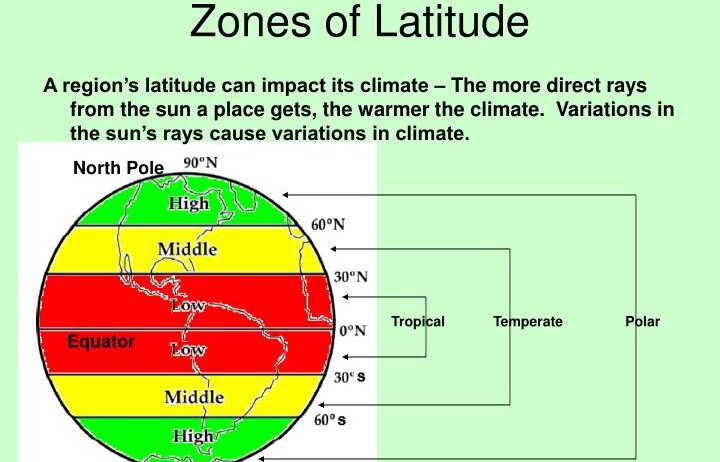Latitude serves as one of the most significant determinants of the Earth’s climate zones. It fundamentally influences the distribution of solar energy received, thereby shaping temperature patterns and precipitation levels across the globe. Understanding the relationship between latitude and climate not only unveils the underlying mechanisms of weather systems but also informs our approach to environmental challenges, biodiversity, and sustainability.
The Earth is divided into various climate zones, which are primarily categorized based on latitude: tropical, subtropical, temperate, and polar regions. Each of these zones exhibits unique climatic characteristics, influenced predominantly by their position relative to the Equator.
To appreciate the nuances of how latitude affects climate, one must first consider the basic principles of solar radiation. The angle at which sunlight strikes the Earth varies significantly with latitude. Near the Equator, sunlight arrives at a more direct angle, resulting in higher temperatures and more consistent weather patterns. Conversely, as one moves towards the poles, sunlight strikes at a more oblique angle, leading to reduced solar energy absorption, colder temperatures, and marked seasonal variations. This general principle elucidates why tropical regions are characterized by a warm, humid climate, while polar regions experience frigid conditions.
The interplay of latitude with atmospheric circulation further complicates climate patterns. The Earth’s rotation and the distribution of land and sea create prevailing winds and ocean currents, which influence temperature and precipitation across different latitudes. Trade winds in tropical regions, westerlies in temperate zones, and polar easterlies in the arctic contribute to weather systems that reflect the latitudinal position.
Furthermore, geographical features such as mountains can exacerbate climatic differences within latitude zones. These features can establish rain shadows, where one side of the mountain range receives moist air leading to precipitation, while the other side remains arid. Consequently, even within a single latitude band, local climates can drastically differ, adding another layer of complexity to our understanding of climate dynamics.
Moving beyond physical characteristics, latitude shapes biomes—the distinct ecological communities prevalent in each climate zone. The biodiversity within these biomes is often a direct result of climate-latitude interactions. Tropical rainforests flourish near the Equator due to year-round warmth and moisture, creating a rich tapestry of plant and animal life. In contrast, temperate forests and grasslands, located at higher latitudes, experience seasonal changes that dictate the rhythm of life cycle events such as flowering and migration.
In the polar regions, the extreme conditions lead to unique adaptations both for flora and fauna. Species in these zones exhibit remarkable resilience; for instance, the polar bear’s thick fur and body fat are essential for survival in frigid temperatures, while certain plants have evolved to withstand freezing temperatures and long periods of darkness. Latitude’s impact on climate zones is thus interwoven deeply with the adaptation and distribution of life on Earth.
Climate change is a pressing issue that further amplifies the significance of latitude in determining climate zones. As global temperatures rise, the delicate balance of ecosystems is increasingly disrupted. For instance, warming trends are leading to shifts in habitat ranges, threatening biodiversity and leading to the potential extinction of species unable to adapt to changing conditions. The implications are profound, as these shifts are often more pronounced in polar and temperate regions.
Moreover, as weather patterns shift due to climate change, so too does the phenomenon of extreme weather events, affecting agricultural productivity, water availability, and human health. Regions historically characterized as temperate may experience drought or flooding, reshaping their climatic identities. Understanding these shifts through the lens of latitude provides critical insights into resilience strategies that communities must adopt in the face of climate change.
Global efforts to combat climate change hinge upon the recognition of latitude’s impact on climate zones. Policies legislating emissions reductions, sustainable land use, and conservation efforts must consider local climate characteristics. Communities must become adept at adapting to their unique climatic conditions, which are inherently tied to their latitude. Strategies can range from altering agricultural practices to mitigate food security risks to revising urban planning to account for shifting precipitation patterns.
In conclusion, the intricate relationship between latitude and climate zones holds considerable relevance for understanding our world and its ecological networks. From shaping temperatures and precipitation patterns to influencing agricultural practices and biodiversity, latitude serves as a foundational element in the tapestry of Earth’s climate system. As we navigate the complexities of modern environmental challenges, grasping the importance of latitude’s role in determining climate characteristics is integral to fostering a sustainable future. The convergence of ecological understanding with climate science will be pivotal in guiding active stewardship of our planet’s health.






